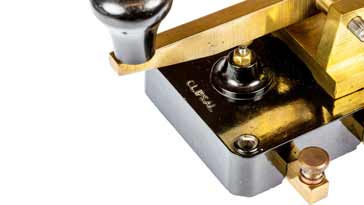Clipsal Morse Telegraph Key
The Clipsal Morse key was manufactured by Gerard and Goodman in Australia for use by the Australian forces in WW2
Morse Telegraph History Includes:
Morse telegraph history
Morse keys development
Vibroplex & mechanical bug keys
Telegraph sounder
Morse inker
Samuel Morse
Fascinating facts
Morse code SOS message
Morse keys:
Clipsal key
Camelback
Walters Electrical Patt 1056A Post Office key
Steel lever Morse telegraph key
RAF Bathtub Morse key
Samson ETM-5C electronic keyer
The Clipsal morse key was manufactured in Australia by Gerard and Goodman in Australia. It has rather a striking appearance with the black bakelite base contrasting with the brass lever, contacts and bearing mount.
The Clipsal key is not the same as the Australian PMG (Post Master General) key with which it is sometimes confused, although there are some similarities in the style and construction.
Video: Clipsal Morse key
Clipsal Morse key features
The Clipsal Morse key features a black bakelite base which measures just over 4 ½ long by just over 2 ¾ inches wide and the whole key is about 3 ⅜ inches high.

The key has a black bakelite base and brass is used for the fittings and the straight, wide, and flat lever. The handle or knob is the same as the British knurled type bakelite knob.
As the lever mechanism and contacts are manufactured from brass this gives the whole assembly a good firm structure and feel.
This makes it about 115 by 70 by 85 mm in metric measurements and the Clipsal key used weighed around 0.45kg.

The Clipsal key came in two versions: one had two contacts and there was also a three contact version. The three contact version allowed for the first contact to be a "make" action when the key was depressed, and the other contact was a "break" action when the key was depressed.

Clipsal key dates
This Morse key started production in the Second World War, around 1941, and it was widely used by the Australian Armed Forces and then after the war, production continued for some while the amateur radio market. With the tooling set up, costs were not so high and some extra revenue could be gained from manufacturing a few further keys.

In use the key had a nice positive action but benefitted like any other key from being firmly fixed down to the desk or table. Some people have commented on how easy it was to use and how it enabled them to send better Morse code as a result.
 Written by Ian Poole .
Written by Ian Poole .
Experienced electronics engineer and author.
More History:
Radio history timeline
History of the radio
Ham radio history
Coherer
Crystal radio
Magnetic detector
Spark transmitter
Morse telegraph
Valve / tube history
PN junction diode invention
Transistor
Integrated circuit
Quartz crystals
Classic radios
Mobile telecoms history
Vintage mobile phones
Return to History menu . . .



